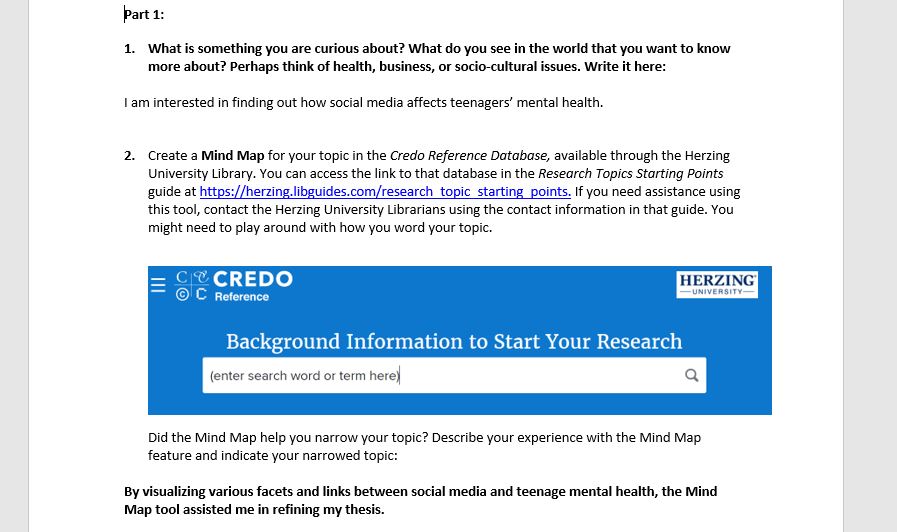Identifying a Topic and Incorrect APA Usage
Assignment Purpose:
The first part of this assignment will assist you in identifying a topic which you will work with for subsequent activities in the course. The second part of the assignment helps you articulate what constitutes plagiarism.
Part 1:
In this course you will be using a variety of resources and research tools. This activity will guide you in formulating a topic to use for later assignments in this course.
(Need help selecting a topic? Review the Research Topic Starting Points guide from the Herzing
University Library. Browse some of the resources linked there for generating topic ideas.
https://herzing.libguides.com/research_topic_starting_points)
- Create a Mind Map for your topic in the Credo Reference Database available through the Herzing
University Library. You can access the link to that database in the Research Topics Starting Points
guide at https://herzing.libguides.com/research_topic_starting_points If you need assistance using
this tool, contact the Herzing University Librarians using the contact information in that guide. You
might need to play around with how you word your topic.
Did the Mind Map help you narrow your topic? Describe your experience with the Mind Map feature and indicate your narrowed topic:
- Write at least three research questions related to your topic and circle or somehow indicate the one you are most interested in answering:
- Create a thesis statement for your research project. Be sure it meets the characteristics of a “strong” thesis statement as described in the reading for this unit.
Characteristics of a Strong Thesis Statement
Answers the research question and is adequate for the assignment.
Takes a position – doesn’t just state facts.
It is specific and provable.
It passes the “so what?” test.
Include your thesis statement here:
Part 2:
The following paragraph is from this source:
Spiranec, S., & Mihaela, B. Z. (2010). Information literacy 2.0: Hype or discourse refinement? Journal of
Documentation, 66(1), 140-153. doi:http://dx.doi.org.prx-
herzing.lirn.net/10.1108/00220411011016407
Web 2.0 is currently changing what it means to be an information literate person or community…. The erosion did not begin with Web 2.0 but had started considerably earlier and became evident with the first web document without an identifiable author or indication of origin. Generally, this erosion comes naturally with the advancement towards electronic environments. In the era of print culture the information context was based on textual permanence, unity and identifiable authorship, and was therefore stable. The appearance of Web 1.0 has already undermined that stability by the very nature of digital information which may be easily modified, copied and duplicated. Web 2.0 with its collaborative model of knowledge production and mash-up philosophy finally brought an end to the stability of information context by creating flat and fluid information spaces. (Spiranec & Mihaela, 2010, p. 147)
Below are four examples that display usage of this content. For each one, please determine whether or not plagiarism is present. If you feel a passage is plagiarized, explain why. If you feel it was not plagiarized, explain what necessary details are present that show correct usage.
b. Spiranec and Mihaela (2010) argue that the Internet has “brought an end to the stability of information context” (p. 147).
d. Web 2.0 is currently changing what it means to be an information literate person or community.
This activity is adapted from page 85 of Hosier, A., Bullis, D., Bernnard, D., Bobish, G., Holden, I., Hecker,
J., . . . Jacobson, T. (2014). The information literacy user’s guide: An open, online textbook. Retrieved
from http://textbooks.opensuny.org/the-information-literacy-users-guide-an-open-online-textbook/ ,
Licensed under Creative Commons BY-NC-SA 3.0
Answer preview for Identifying a Topic and Incorrect APA Usage

APA
300 Words
